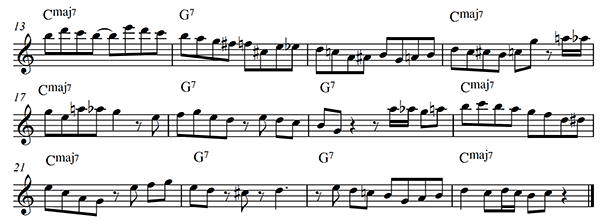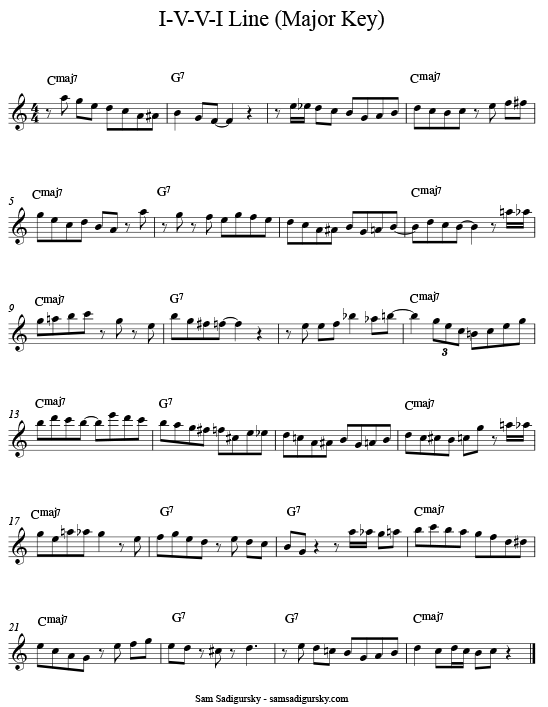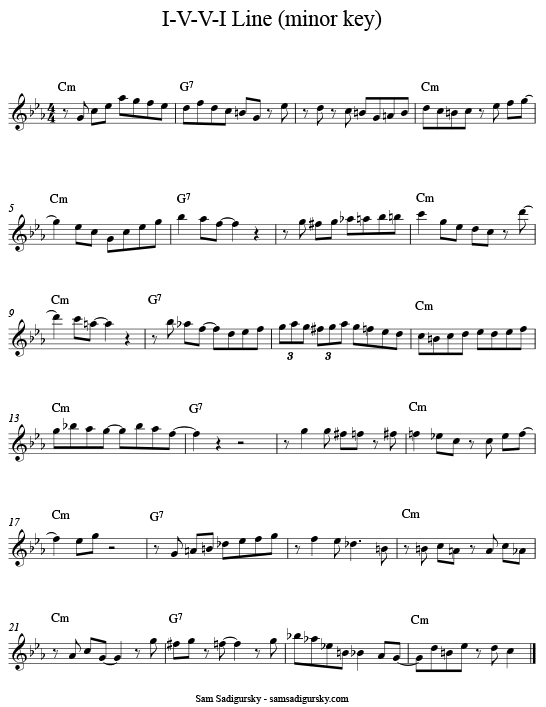Overcoming the Challenge of Soloing Over Simple Chord Progressions
 Like many of you I’m sure, my first loves on jazz saxophone were people like Charlie Parker, Cannonball Adderley, Phil Woods, Stan Getz, John Coltrane, Hank Mobley, Joe Lovano, Michael Brecker, etc…. you get the idea – the modern lineage that I connected to easily and shaped this music that we love.
Like many of you I’m sure, my first loves on jazz saxophone were people like Charlie Parker, Cannonball Adderley, Phil Woods, Stan Getz, John Coltrane, Hank Mobley, Joe Lovano, Michael Brecker, etc…. you get the idea – the modern lineage that I connected to easily and shaped this music that we love.
I immediately wanted to play the songs they played, spent thousands of hours listening, studying and playing transcriptions, running patterns, learning how to navigate relatively complex chord progressions and also play both “inside” and “outside” the tonality over modal progressions as well.
What I didn’t realize was that the music these greats play and their approach to playing was steeped in a language that was much simpler in origin. I was learning in a backwards way, starting with the complex, and had to start to dig deep in order to discover the roots of the music I so loved.
Why the Easiest Changes Are The Hardest to Play Over
As I first swam through the freelance scene in NYC taking any gigs I could possibly get, I remember being terrified on some of my first Latin, pop, early jazz and even bluegrass gigs when having to solo over very few and extremely simple chord changes, sometimes in fact just a tonic and a dominant chord. My first reaction was often “This is baby stuff – how am I supposed to create something interesting here?” It felt so much easier to plow through the changes of Confirmation, Stablemates or Airegin than play over this.
However, after a lot of embarrassing moments and some a great deal of practice and study at home, I not only grew more comfortable over these barebones progressions, but they became a core part of my practice over the years and a key to unlocking a vocabulary that now informs everything I do today.
Applying Complexity to Simplicity
Dig deep enough, and there are endless possibilities for both simple melody and voice-leading, but also endless chromaticism within these progressions. Dig into early jazz or Latin music and you’ll hear the magic that was created within them, and it’s also interesting to find recordings of the more modern jazz and bebop greats playing over simple material like this. For starters, check out Charlie Parker’s forays in Latin Jazz, or Sonny Rollins playing over the Calypsos of his Caribbean heritage.
Below you’ll find two samples of jazz and bebop inflected lines over a simple I-V-V-I progression in both C Major and C minor.
CLICK HERE TO DOWNLOAD A PRINT-FRIENDLY PDF OF I-V-V-I (Major Key)
CLICK HERE TO DOWNLOAD A PRINT-FRIENDLY PDF OF I-V-V-I (Minor Key)


Use them as a starting off point for your own improvising, and depending on your level, feel free to write your own lines. Make up or grab some other ultra-simple progressions from things you like and start to fly.
As always, work your way through all the keys – make all of them feel as comfortable and easy as C Major!
I’m always eager to hear your thoughts, so please feel free to share them in the comment section below.
Learn with and Listen to Sam
Sam Sadigursky is currently offering online lessons through Skype and private lessons in NYC. He has given improvisation clinics across the U.S., is a regular guest professor at Hunter College, and currently performs internationally with Darcy James Argue’s Secret Society, Folklore Urbano, and others. His new book, 12 INTERVALLIC ETUDES for Saxophone, is available here. His albums can be purchased at http://samsadigursky.bandcamp.com. To find out more, visit SamSadigursky.com.






April 19, 2020 @ 1:02 am
Nice…….Really nice.
Since it is 11:45pm I can’t play it until my normal starting time at 6am. I could only Sight-Sing it in my mind and it sounded really good swinging at around 220 which is a good slow Bebop tempo.
It also seemed like it would be a good Sax Soli. I had a really good Sax Section from 8th grade in High School through college. We were so tight we did Soli’s from memory and could handle Supersax arr like Yard’s “Kim #1” !